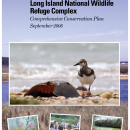What We Do
Wildlife conservation is at the heart of the National Wildlife Refuge System. It drives everything on U.S. Fish and Wildlife Service lands and waters managed within the Refuge System, from the purposes for which a national wildlife refuge national wildlife refuge
A national wildlife refuge is typically a contiguous area of land and water managed by the U.S. Fish and Wildlife Service for the conservation and, where appropriate, restoration of fish, wildlife and plant resources and their habitats for the benefit of present and future generations of Americans.
Learn more about national wildlife refuge is established to the recreational activities offered to the resource management tools used. Using conservation best practices, the Refuge System manages Service lands and waters to help ensure the survival of native wildlife species.
Refuges deploy a host of scientifically sound management tools to address biological challenges. These tools span active water management to wilderness character monitoring, all aimed at ensuring a balanced conservation approach to benefit both wildlife and people. At this field station our conservation tool box includes:
Invasive Species
Invasive plants are a threat because they displace native plant and animal species, degrade wetlands and other natural communities, and reduce natural diversity and wildlife habitat values by out-competing native species for light, water, and nutrients. Invasive plants do occur on the refuge and threaten both aquatic and terrestrial systems.
Once invasive plants have become established, their characteristic abilities to establish easily, reproduce prolifically, and disperse readily make getting rid of them expensive and labor-intensive. Many of them cause measurable economic impacts, particularly in agricultural fields. Preventing new invasions is extremely important for maintaining biodiversity and native plant populations. Controlling affected areas requires extensive partnerships with adjacent landowners and state and local government agencies.
Management and Conservation
Management Goals
Refuge management goals are:
- Provide and manage a diversity of high quality habitats to support breeding, migrating and/or wintering birds, threatened & endangered species, and fish.
- Maintain high quality habitats for all native wildlife and plant species.
- Establish and maintain partnerships to benefit wildlife for present and future generations
Our Projects and Research
Current Projects Include
Refuge staff and Student Conservation Association interns complete saltmarsh vegetation surveys at Wertheim, Seatuck, and Lido Beach each August and September. The team surveys 203 one-meter square quadrats to assess how the salt marsh salt marsh
Salt marshes are found in tidal areas near the coast, where freshwater mixes with saltwater.
Learn more about salt marsh is responding to restoration efforts. During the surveys, the team records percent cover, stem density, and stem height. Hurricane Sandy resiliency projects involve the use of coir logs to fill former mosquito ditches, newly excavated channels to improve tidal flow, thin layer deposition, and a new living shoreline.
Law Enforcement
The mission of the National Wildlife Refuge System Law Enforcement program is:
"Through education and enforcement we protect our employees, volunteers, and visitors; safeguard the public’s investment in facilities and equipment; and protect the integrity of the habitat and the wildlife resources of the National trust resource which is the 150 million acre National Wildlife Refuge System.”


